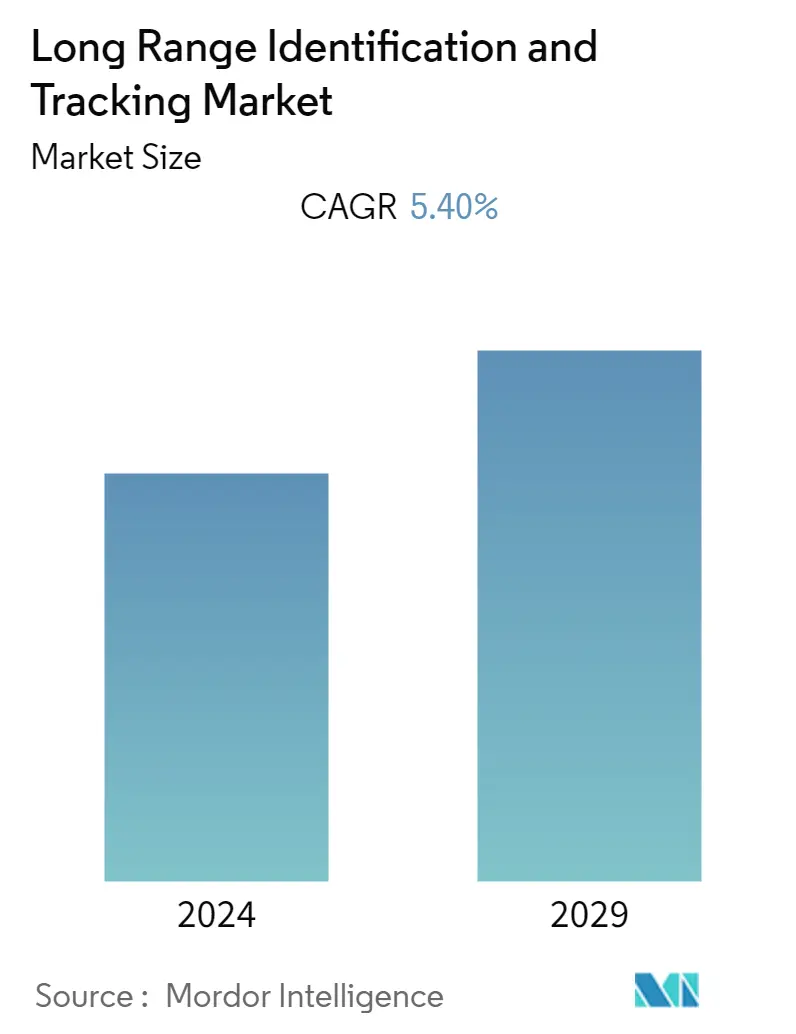Market Size of Long Range Identification and Tracking Industry

| Study Period | 2019 - 2029 |
| Base Year For Estimation | 2023 |
| CAGR | 5.40 % |
| Fastest Growing Market | Asia-Pacific |
| Largest Market | North America |
| Market Concentration | High |
Major Players*Disclaimer: Major Players sorted in no particular order |
Long Range Identification & Tracking Market Analysis
The long-range identification and tracking market registered a CAGR of 5.4% over the forecast period 2021 - 2026. Long-range tracking and identification systems are security and surveillance systems used to identify and track vessels. This system includes ship-mounted long-range tracking and identification systems, information transmitters, application service providers (ASPs), LRIT data centers, communications service providers (CSPs), LRIT data distribution plans, ship monitoring systems, and international LRIT data exchanges.
- Integrating a long-range tracking and identification system into a ship provides governments with information related to the ship's identity and location, helping government agencies mitigate security risks.
- In addition, the benefits of long-range tracking and identification systems such as sea search and rescue, marine environmental protection, and maritime safety are expected to drive the extended-range tracking and identification system market.
- Major countries use it to integrate the technology and infrastructure needed to integrate LRIT into the maritime sector to maintain vessel tracking and gain insights into safety and productivity associated with various routes at sea.
- Panama is a leader in the LRIT market, with more than 8,000 vessels using this technology. Meanwhile, other South American countries have emerged as the leading candidates for the market and have adopted this technology as early as 2010.
Long Range Identification & Tracking Industry Segmentation
The Long-Range Identification and Tracking (LRIT) system enhances ship security and provides global identification and tracking of ships for safety and marine environmental protection purposes. The obligations of vessels to transmit LRIT information, the rights and obligations of SOLAS Contracting Governments, and the obligations of search and rescue services to receive LRIT information are set out in Rule V / 19-1 of the 1974 SOLAS Convention. The market is segmented as follows:
| By Platform | |
| Onshore-based Platform | |
| Vessel-based Platform |
| By Components | |
| Communications Service Providers | |
| Application Service Providers | |
| Data Center and Distribution Providers | |
| Others |
| By End-users | |
| Government | |
| Defense | |
| Commercial |
| By Region | |
| North America | |
| Europe | |
| Asia-Pacific | |
| Rest of the World |
Long Range Identification and Tracking Market Size Summary
The long-range identification and tracking market is experiencing steady growth, driven by the increasing need for security and surveillance systems in maritime operations. These systems, which include ship-mounted tracking devices, information transmitters, and data centers, are essential for identifying and monitoring vessels to mitigate security risks. The market is further propelled by the benefits these systems offer, such as enhancing maritime safety, environmental protection, and search and rescue operations. Major countries are integrating this technology into their maritime sectors to improve vessel tracking and gain insights into safety and productivity at sea. The Asia Pacific region, with its significant military presence and busy sea routes, plays a crucial role in the market due to rising border conflicts and the need for advanced tracking systems.
Key players in the market, such as Pole Star Space Applications Limited and Morsviazsputnik, are expected to see substantial revenue growth due to the global demand for intelligence, surveillance, and reconnaissance systems. The market is also influenced by military investments in new naval vessels, particularly in the United States and NATO countries, which are equipping their fleets with advanced tracking and identification systems. Collaborative efforts, such as the establishment of the Trilateral Secretariat for Maritime Security Cooperation and the UK's involvement in the Indian Ocean Surveillance Hub, highlight the international focus on enhancing maritime security. Additionally, innovations like the integration of satellite data with unmanned aerial vehicles for maritime operations underscore the market's dynamic nature and its potential for continued expansion.
Long Range Identification and Tracking Market Size - Table of Contents
-
1. MARKET DYNAMICS
-
1.1 Market Overview
-
1.2 Introduction to Market Drivers and Restraints
-
1.3 Market Drivers
-
1.4 Market Restraints
-
1.5 Industry Value Chain Analysis
-
1.6 Industry Attractiveness - Porter's Five Force Analysis
-
1.6.1 Threat of New Entrants
-
1.6.2 Bargaining Power of Buyers
-
1.6.3 Bargaining Power of Suppliers
-
1.6.4 Threat of Substitute Products
-
1.6.5 Intensity of Competitive Rivalry
-
-
-
2. MARKET SEGMENTATION
-
2.1 By Platform
-
2.1.1 Onshore-based Platform
-
2.1.2 Vessel-based Platform
-
-
2.2 By Components
-
2.2.1 Communications Service Providers
-
2.2.2 Application Service Providers
-
2.2.3 Data Center and Distribution Providers
-
2.2.4 Others
-
-
2.3 By End-users
-
2.3.1 Government
-
2.3.2 Defense
-
2.3.3 Commercial
-
-
2.4 By Region
-
2.4.1 North America
-
2.4.2 Europe
-
2.4.3 Asia-Pacific
-
2.4.4 Rest of the World
-
-
Long Range Identification and Tracking Market Size FAQs
What is the current Long Range Identification and Tracking Market size?
The Long Range Identification and Tracking Market is projected to register a CAGR of 5.40% during the forecast period (2024-2029)
Who are the key players in Long Range Identification and Tracking Market?
Pole Star Space Applications Limited, Morsviazsputnik, China Transportation Telecommunication Center, Arskom Group and Fulcrum Maritime are the major companies operating in the Long Range Identification and Tracking Market.

